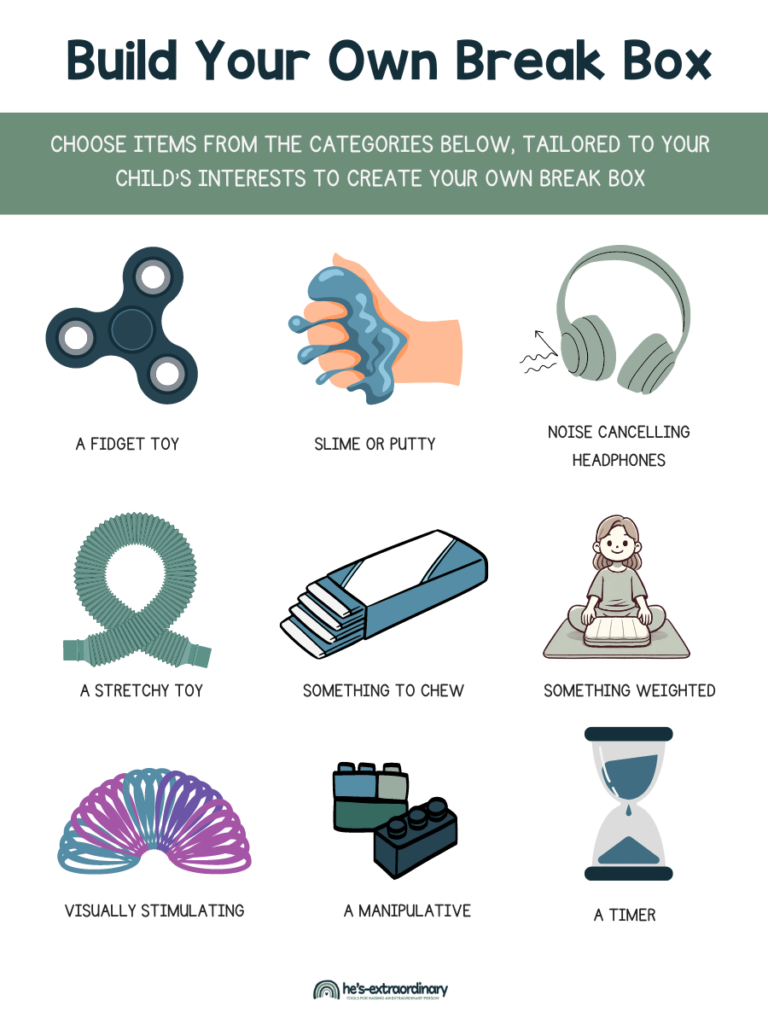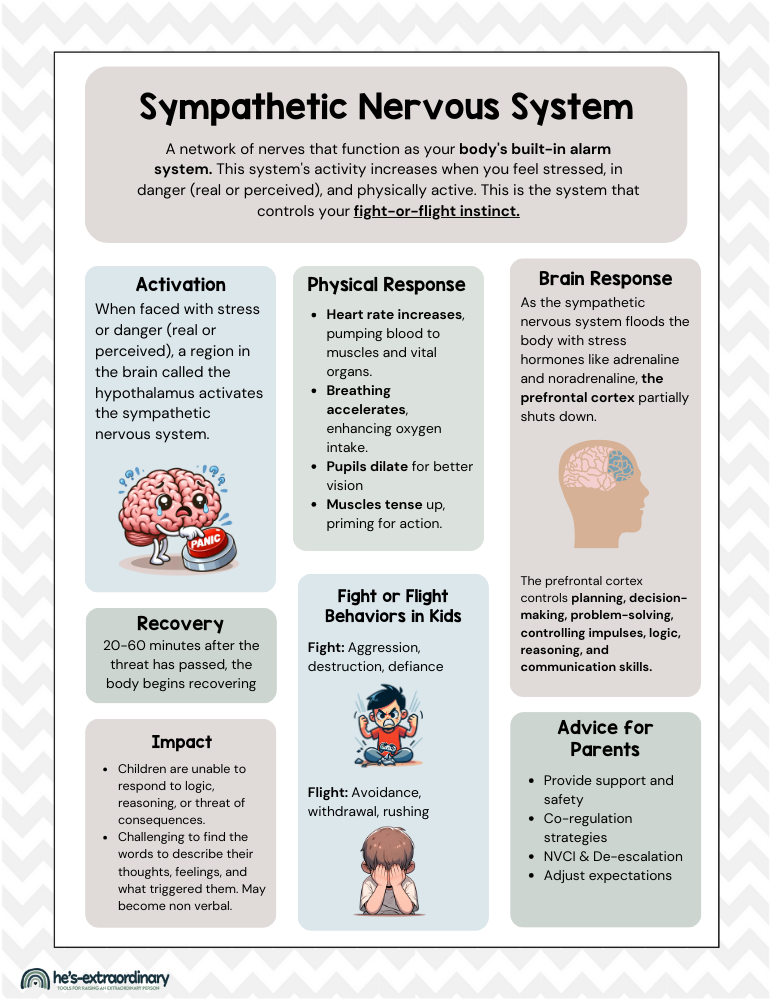The Ultimate Guide For Preventing Meltdowns in Your Autistic Child
What’s inside this article: Any overview of the escalation cycle, in other words, the stages of a meltdown, along with in-depth advice for preventing meltdowns in children with autism.
Disclaimer: This post contains affiliate links.
Meltdowns are no joke, and they’re definitely not “temper tantrums.” If you have ever dealt with a child having a meltdown, then you know that de-escalating the situation is no easy feat. Actually, it’s nearly impossible to stop autism meltdowns once they’ve begun.
A meltdown may seem unpredictable and include aggressive or destructive behavior.
It is very different from a temper tantrum because the child is not in control of themselves during the outburst. So, knowing how to prevent autism meltdowns proactively is a more successful approach than de-escalation.
It’s helpful to understand how your child’s nervous system impacts emotional regulation and meltdowns. You can learn more about it here.
To be successful at preventing meltdowns, you must be able to:
Anatomy of a Meltdown – The Escalation System
The diagram below is a representation of what happens to a person’s emotional state as a meltdown occurs.

First, when a child is calm, they follow directions, ignore distractions, and accept praise and feedback. This is the ideal state.
Be sure to also read about these 6 NVCI strategies for handling meltdowns. These strategies are useful at all stages of the escalation cycle.

Calm – Time For Prevention
When your child is calm, you should always focus on preventing meltdowns.
Use positive reinforcement often and give your child opportunities to be successful. Our brain is wired to accept reinforcement better than consequences.
When your child is calm, they are the most receptive to information. You should use this time to communicate positive expectations and practice coping skills and self-regulation strategies.
Children can’t learn new coping skills when they are already triggered or experiencing a meltdown because after their sympathetic nervous system is activated, their prefrontal cortex (thinking part of the brain) begins to shut down.
Strategies For When Your Child Is Calm
The following strategies are beneficial when your child is feeling calm.
1. Activities That Promote Relaxation:
- Practice Deep Breathing: Deep breathing regulates our arousal level by lowering our heart rate, blood pressure, and stress hormones. That’s why it’s such a great way to calm down our bodies and self-regulate. However, it takes practice to use this skill correctly. Use these deep breathing exercises to practice this essential skill with your child when they’re feeling calm.
- Play Mindfulness Games: I recently attended a webinar hosted by ADDitude magazine about using mindfulness activities to improve attention, focus, and self-regulation. The webinar presenter recommended these mindful games activity cards, and I love them. They’ve become my go-to product recommendation for practicing mindfulness with kids.
- Child-Directed Guided Meditations: My son has had success doing guided meditations directed at children. He says they help him block out irritating sensory input, such as noises from traffic or other people talking around him. Find fun-themed guided meditations for kids here.
What if your child doesn’t want to practice relaxation strategies?
You may have trouble getting your child to participate in these calm and quiet activities at first. Especially if your child is really active and energetic or has a PDA profile.
This is normal and should be expected. However, you can begin by modeling these strategies, encouraging your child to practice them in small intervals and build up to longer intervals over time.
For example, if your child is practicing deep breathing but can only focus for 30 seconds, that’s fine. Give them positive reinforcement for trying. Then, encourage them to practice for 35 seconds the following day.
It’s essential to practice these activities often when your child is calm so that when they do become upset, you can prompt them to do their breathing then, too. You can’t teach calming techniques to your child mid-meltdown.
2. Proactively Address Sensory Challenges:
- Meet Sensory Needs: Understimulation and overstimulation (sensory overload) can both cause disruptive behaviors and trigger meltdowns. How a child reacts to sensory experiences throughout the day can give you clues to their sensory needs. Then, you can ensure their needs are met through various sensory integration activities and equipment.
- Example: If your child is sensitive to loud noises, ensure they have access to a quiet, calming space, or bring along a pair of noise-reducing headphones.
- Read: 50+ Solutions to Common Sensory Issues and Triggers.
- Provide Regular Sensory Breaks: Short but frequent breaks for sensory activities, sometimes called sensory snacks, help prevent meltdowns. Occupational therapists recommend spending 5-10 minutes each hour doing a sensory activity. This is more effective than taking longer sensory breaks in less frequent intervals.
- This 7-minute HIIT workout for kids or this 8-minute morning workout are both short, full-body sensory breaks that improve focus and prevent sensory-related meltdowns in sensory seekers.
3. Plan Your Schedule and Practice Your Exit Strategy
- Create a Schedule: Children thrive when they have structure through consistency and predictability. One of the easiest ways to provide that is through a schedule or a daily routine. This works best when your child can view the schedule (it could be visual or written, depending on age), so they can always feel reminded of what to expect if any uncertainty arises.
- Have an Exit Strategy: An exit strategy is a pre-planned way for your child to communicate with you (nonverbally) that they’re finding a situation or environment stressful and triggering. It should also include what they can do and where they can go when they feel like they need to get away quickly. These take practice, but an exit strategy is a great way to give your child extra control and have them prepared for potential triggers.
- Example: When attending a school dance, we know the environment is going to be loud, warm, and crowded. The noise could be a trigger, but getting bumped into or not being able to see me could also be triggering. So, we have a hand signal that would alert me that it’s time to take a break. But, in case he can’t see me, my son also knows he’s allowed to exit through the side door on his own and wait near the water fountain in the quiet, empty hallway, and I will meet him there.
Trigger: Be Proactive
After a “trigger,” your child is no longer in a calm state. The trigger is the turning point that could lead to a meltdown, depending on what happens next. At this point, your child’s sympathetic nervous system is activated, and many automatic changes start taking place inside their body.
You must recognize the trigger when it occurs and start using the
If you realize and intervene at the trigger, there’s an 80-90% chance you can prevent the situation from escalating.
Possible Triggers:
Everyone is different and will have their own unique triggers. You know your child better than anybody and will likely be aware of many of their triggers. It may be helpful to keep a journal as well to look for any emerging patterns and identify their triggers.
These are just a few examples of common triggers:
- Repeated failures or frustrations – in other words, being expected to do things they can’t do
- Low rate of positive reinforcement
- Unexpected event – sudden change from routine
- External sensory issues – lights, noise, smells, etc
- Internal sensations – hunger, thirst, feeling tired, sick, or in pain, etc. Keep in mind that children may not be able to communicate or understand their internal sensations or unmet needs, so it can require detective work.
Warning Cues:
These cues may be subtle and require a keen eye to notice. Children have unique cues, and you will know what your child’s signals are better than anybody else, but here are some things to look out for that may indicate a trigger:
- Changes in body language
- Physiological changes such as redness in the face/ears
- Tensing up
- Stimming
- Pacing, unable to sit still
- Scratching/picking, etc.
- Echolalia
- Change in tone of voice
After a trigger, focus on intervention and redirection to be supportive of non-escalating behavior and prevent the meltdown.
What To Do After A Trigger
After you’ve noticed warning cues and identified the trigger, you need to intervene. Consider some of the following interventions:
1. Remove or Modify The Trigger (Sensory Related Triggers):
If the trigger is sensory-related, modify the environment or accommodate the child.
Some examples include:
- Dimming the lights
- Provide a fidget toy or offer a movement break
- Move the child to a less stimulating environment
- Provide access to sensory equipment like noise-reducing headphones or a sensory swing.
Your goal is to help your child return to that “just right” zone they need to feel calm by either reducing or increasing the amount of sensory input to meet their unique sensory needs.
2. Increase Opportunities for Success:
If your child is feeling frustrated after repeated failures, create opportunities where they will be successful.
For example, ask or direct them to a task or activity you know they do well, then increase the amount of positive reinforcement you are using.
The positivity can ease some of your child’s frustration and help them feel calm again. Make sure they have adequate time to self-regulate before returning to the frustrating activity/situation and provide additional support with whatever initially triggered them.
3. Create a Break Box:
Collect 15-20 small items you can keep together as part of your break box.
When you start seeing cues that your child is frustrated, allow them to take a short break with their break box to do a calming activity.
You can include things like coloring books, fidgets, play-doh, puzzles, word searches, etc.

You should tailor the break box to your child’s interests. It’s easy to create your own by picking up some dollar store items.
We keep our break box in our calming corner, and taking a 5-10 minute break there together (co-regulation) often helps get everything back on track.
Check out our calm down corner and our $10 box here.
4. Address Unmet Needs and Internal Problems Promptly
Sometimes, unmet needs and internal problems (like feeling hungry, thirsty, tired or cold) can take a little detective work because many children with autism don’t know how to communicate and describe what they feel happening inside their bodies.
They may not recognize cues of hunger until they’re starving or understand the connection between their emotions and physical sensations. These are all parts of your child’s interoceptive system.
However, it is imperative that you notice and address these needs because no amount of manipulating the environment will help your child if the problem is internal.
Offer a drink or snack, or ask them if they are in pain or feeling ill. Learn more about interoception here.
Agitation – Intervene Now
Once your child reaches a state of agitation, you will start seeing an increase in challenging behaviors. If you intervene successfully now, you may have a 30-40% chance of preventing the situation from escalating to a meltdown.
During this stage, you will notice behaviors such as:
This is your last chance for intervention if you are going to prevent the meltdown.
When your child is in a state of agitation, their frustrations are incredibly close to overflowing into a full meltdown. Their fight-or-flight instinct is going to take over.
1. Answer the question – why?
You’ve presumably missed the trigger or caught the trigger too late. So, ask yourself now: What purpose does the behavior have? Understanding why your child is acting a certain way is the key to changing it.
To plan a successful last-chance intervention, you must understand its function. What is the outcome of their challenging behavior? Does it remove them from a situation? Does it help them meet sensory needs? Does it communicate pain, discomfort, or an unmet need? Does it lead to you redirecting them to a more preferable activity?
These are the types of questions you can ask yourself to try to figure out the why.
2. Change Environments:
Immediately remove your child from their current environment and go somewhere else for a break. This could mean changing from one room to another, going for a short walk outside, or moving to a calming corner or a sensory room, if available.
If the trigger was something from within that environment, even if you haven’t figured out exactly what it is, then the change of scenery can help calm your child.
If you have identified a sensory issue, ensure it’s been addressed before returning to the environment or task that led to agitation.
3. Give Your Child Reasonable Options/Choices
When children are frustrated, they often feel like they have lost control of a situation or their personal autonomy. In this emotional state, making small changes to how you phrase things can have a significant impact on how they feel and react.
Phrasing requests or expectations in a non-directive manner by offering reasonable choices and options can help your child feel like they have more control over what’s happening to them.
Instead of instructing directly, present options to your child. For example, “Would you like to start with math or reading today?” or “Do you want to wear your green shirt today or your purple one?”
4. Match Your Child’s Language or Stop Talking
When your child is on the verge of a meltdown, communication becomes increasingly difficult to process.
Matching your child’s language can help you make sure you’re talking in a way that they can understand. So if your child speaks to you in two-word phrases, respond in two-word phrases, not full sentences.
Then, make sure you’re giving them time to process what you’ve said. If you start repeating yourself before you have given your child time to process what you said the first time, they will become more frustrated and unable to follow your instructions.
Processing time increases as stress levels increase. While waiting for a response, try counting to 5 in your head before speaking again.
5. Use Positive Engagements
Look for opportunities to use positive reinforcement. As the saying goes, every cloud has a silver lining. Even if your child is acting out, search for the positive in the situation and use it.
If your child is stomping their feet and protesting as they pack their bag for school, but they are packing their bag for school, notice the good and ignore the negative for now. (These things can always be addressed later when everyone is calm)
Sometimes, adding humor to the situation helps, too. For example, once, my son kicked his shoes off angrily while in the car. I picked his shoes up and used silly voices to make each of his shoes “talk” to him about how they liked when he wore them.
It soon had him giggling, and I was able to stop the situation from escalating and get him to put his shoes back on.
You may also find these de-escalation strategies helpful at this stage because different strategies work for different children.
Acceleration – Escalation Will Run Its Course
Unfortunately, once your child has reached the point of acceleration, the escalation of the meltdown will most likely need to run its course.
You must understand that, at this point, your child has lost control of their behavior. This is an autonomous nervous system response and not a conscious choice they are making to misbehave.
Meltdowns may include behaviors including:
At this point, maintaining everyone’s safety is the most important thing.
It’s critical to understand that a meltdown is not intentional misbehavior, manipulation, or something your child can choose or control. Therefore, telling them to stop or threatening to enforce punishments or consequences will only add to the situation.
1. Use Non-Violent Crisis Intervention (NVCI) skills
- Prioritize Safety: Remove anything that could be potentially dangerous to yourself or your child. Move away, granting additional personal space as long as your child is safe. This is to ensure your own safety, and because the size of our “bubble” increases, the more escalated we feel. Do not touch or attempt to move your child unless they are in a dangerous place, like near a sharp corner or the stairs.
- Remove the Audience: If other people are around, have them leave or at least move out of eyesight and earshot. This is an extremely vulnerable mental state where your child perceives they are in danger. It’s better to have fewer people involved. Others attempting to intervene can prolong the meltdown.
Read this article to learn about six important NVCI skills for parents to use during autism meltdowns.
2. Disengage
Just stop talking.
I can’t stress this enough. At this point, your child cannot process what you are saying. There is no reasoning with them or explaining right now, and they will not be receptive to anything you say.
If they talk to you, answer with one or two words.
3. Try De-escalation techniques
The success rate of prevention is far higher than that of de-escalation. However, sometimes it’s unavoidable, so it’s essential to have some de-escalation techniques, too. Click here for 18 de-escalation techniques.
There is no magic method to turn a meltdown off, but our actions, body language, facial expressions, and behavior can all help remind our children that they are safe and decrease the duration of the meltdown.
I know some of these techniques may seem more like “what not to do,” but sometimes, our responses only make situations more volatile and prolong the meltdown.
You can also find verbal de-escalation techniques here.
Peak
The peak is the most severe part of the meltdown. Continue the same way as you were during the acceleration while focusing on safety.
Deceleration —-> Recovery
After the peak begins the deceleration. At this point, the behavior becomes less and less severe.
When your child reaches the state of depletion, they will feel drained. During this time, focus on re-establishing your child’s routine and starting anew. Do not nag, blame, punish, or force apologies.
Your child is recovering from an extremely stressful event.
As the body begins relaxing, the prefrontal cortex begins to come back online. This reactivation is crucial. It means your child will be better able to think clearly, make choices, communicate, and regulate their emotions.
Recovery may take 20-60 minutes for a child who has occasional meltdowns, but for children who experience frequent or prolonged stress, it can take several hours to even days before they return to a completely calm state.
After recovery, when your child is calm, you can address and talk about what happened. This is the ideal time to give any consequences (when appropriate), explain why, and talk about expected behavior. You should work on teaching replacement behaviors and practicing calming activities once again.
Look back at where things started to go awry and plan what you can do next time to prevent the same escalation from occurring. Any insights you can get from your child about what they were thinking and feeling and why will be invaluable.
How to Successfully Prevent Autism Meltdowns
To successfully prevent autism meltdowns, you must intervene early. Prevention is always ideal, but realistically, that is not always possible. Triggers can happen unexpectedly and may be unpredictable.
It’s important to be ready to intervene at the earliest sign of frustration. The earlier you begin intervention, the more likely you will be able to successfully prevent the situation from escalating into a full-blown meltdown.
If your child has just had a meltdown, think about the following questions:
Behavior Management Strategies
Challenging behaviors are prevalent with autistic children, but it’s not because they are choosing to be “bad” or want to upset you. These behaviors stem from being unable to communicate effectively, not having strong social-emotional skills, sensory challenges, and distinct anxiety.
I created a 30-minute mini-workshop called Meltdown Magic, which includes a 50-page guide for preventing meltdowns. You can see the workshop and digital guide here.
Successfully preventing meltdowns and managing behavior positively is a process that takes time. It involves teaching your child important skills, practicing them over and over, intervening early, educating others, and ensuring your child feels safe and heard.
Over time, with the right strategies, meltdowns will occur less frequently and with less intensity.



